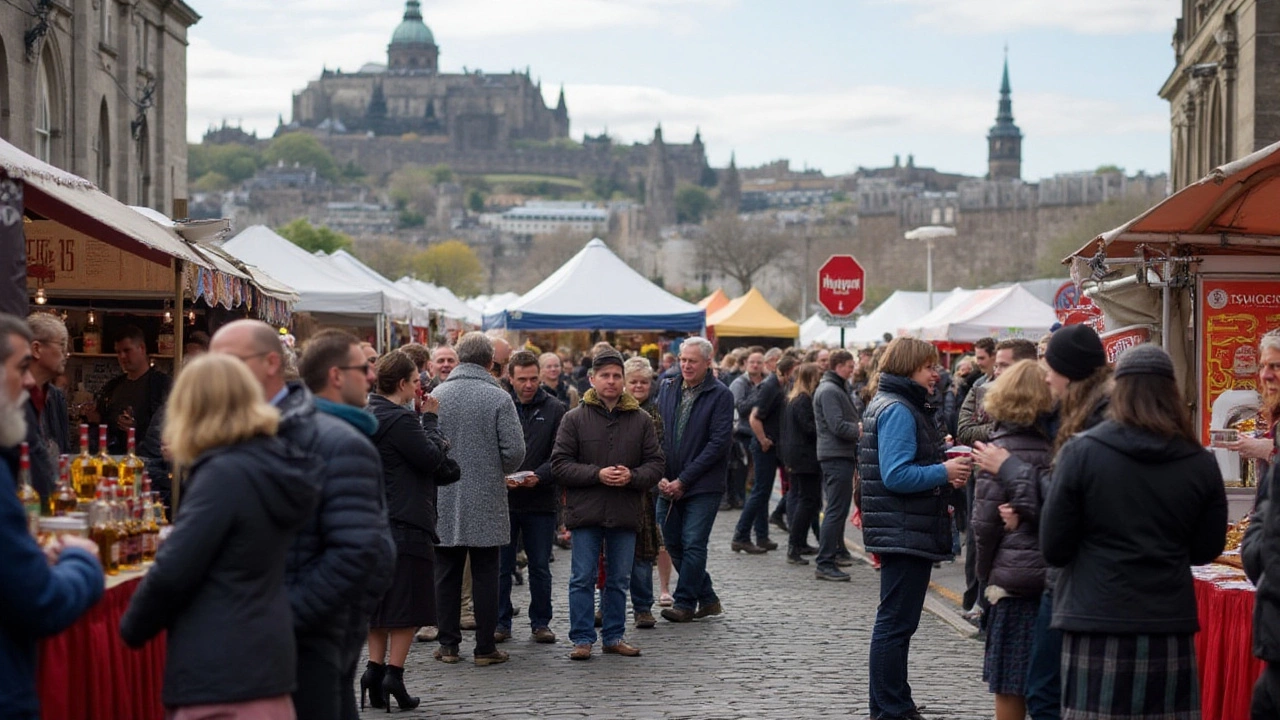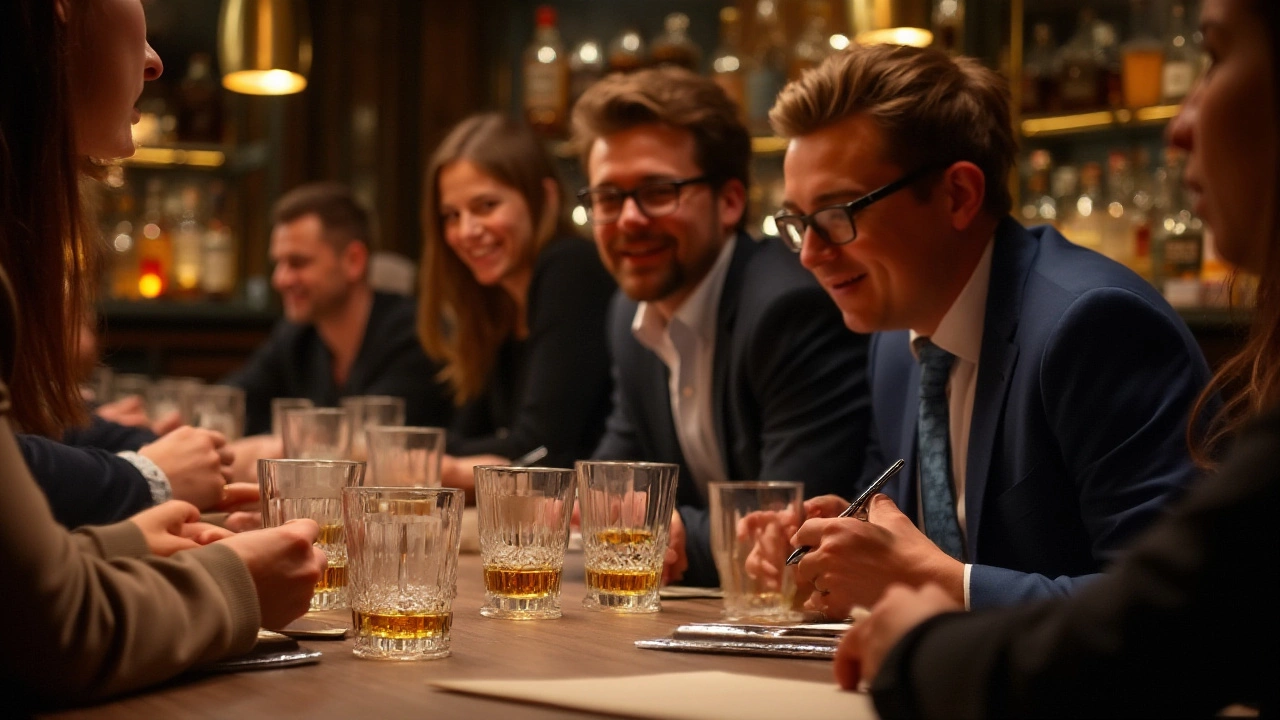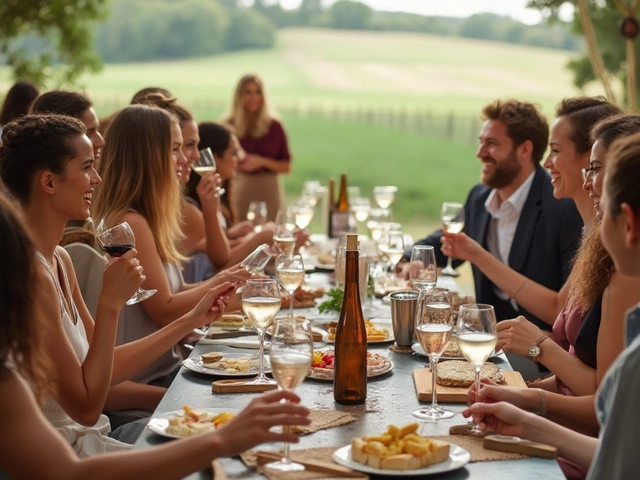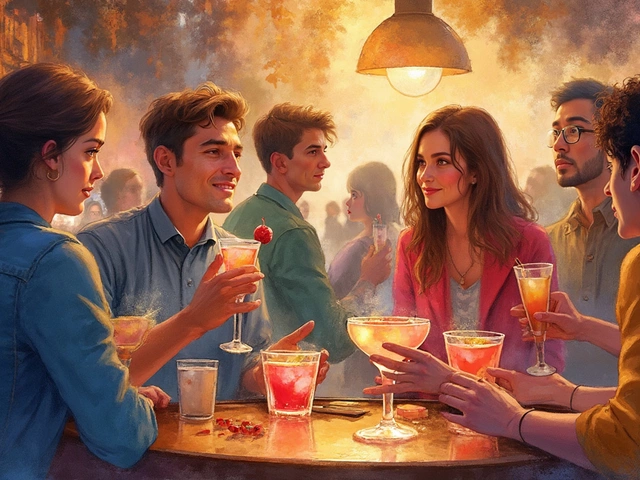Stepping into the world of whisky tastings opens the door to a rich, historic culture of flavors and aromas that intrigue the senses. It's a leisurely journey through the spirit's subtle intricacies, guided by the ambiance and enriched by the company of fellow enthusiasts. Whether you're a seasoned connoisseur or a curious newcomer, a whisky tasting can be an illuminating adventure, offering a unique peek into the myriad expressions of whisky.
Essentially, at a whisky tasting, guests are invited to sip and savor a curated selection of whiskies, each offering its own character and story. The experience extends beyond mere consumption, encouraging participants to hone their sensory skills and develop a deeper appreciation for the craft. In a world where passion meets precision, these tastings serve as both an educational journey and a celebration of one of the world's most beloved spirits.
- The Art of Tasting
- Ambience and Atmosphere
- Whisky Types and Flavors
- Sensory Exploration
- The Role of the Host
- Tips for First-Time Tasters
The Art of Tasting
Embarking on a whisky tasting journey is much more than simply taking a sip of alcohol; it is about immersing oneself in an experience that engages all five senses. The art of whisky tasting begins with understanding and acknowledging the craftsmanship behind each bottle. Whisky lovers often say that a tasting is like reading a novel, where every element tells a story, and each chapter unfolds new and exciting twists. From the moment one opens a bottle to the lingering finish, each step is deliberate, encouraging a deeper connection with the drink.
A crucial starting point is observing the whisky's color and texture. Pouring it into a glass, one should take a moment to observe its hue. The color can reveal a great deal about a whisky's age or the type of cask used for maturation, which ranges from pale straw to deep amber. Afterward, gently swirling the glass, watch how the whisky's legs slowly descend, providing insights into its viscosity and alcohol content.
Next, the olfactory journey begins. A gentle swirl releases the whisky's aroma, allowing an intricate bouquet to rise. It's essential to draw in the scent slowly, initially keeping the nose at a distance. Whisky has varied scents, from the fruity notes of apples and apricots to the earthy aromas of smoke and leather.
Jim Murray, a respected whisky writer, once mentioned, "Each whisky has a bouquet that tells you more in a few seconds than what some people talk about in a few years." This olfactory revelation is crucial, as the nose is more sensitive than the palate, providing an anticipatory glimpse into what flavors to expect.
The tasting itself is where expectations meet reality. A small sip is urged, letting the whisky coat the tongue, allowing the taste buds to explore the myriad of flavors. The complexity of whisky can be multifaceted, with primary, secondary, and tertiary flavors revealing themselves in delicious succession. Enthusiasts often employ a technique known as 'chewing,' moving the whisky around the mouth to explore its full spectrum. This helps to uncover flavors ranging from the sweetness of vanilla and honey to the spice of pepper or a lingering smokiness.
Once the flavors are discerned, the finish, or aftertaste, is observed. The length and characteristics of the finish can vary, sometimes lasting several minutes, leaving warm or spicy residues. The finish is as crucial as the initial sip, offering a satisfying closure to the tasting experience. Some whiskies provide a clean finish, while others are more robust and enduring. The magic of whisky tasting lies in these contrasts, the balance between intense flavors and subtle notes.
Engaging in whisky tasting often includes comparing notes with others. This social element enhances the experience, as sharing impressions can reveal new insights and deepen understanding. Every participant may pick up different subtleties, weaving a richer tapestry of language and perception around the whisky in question. Each session is a unique journey, fueling deeper appreciation and passion for the craft. These experiences, coupled with the shared enjoyment of whisky events, are what make whisky tasting both an art and an adventure.
Ambience and Atmosphere
When attending a whisky tasting, the ambience and atmosphere play a pivotal role in shaping the entire experience. Each venue meticulously crafts its environment to reflect the deep heritage and sophistication that the world of whisky embodies. Imagine walking into a room softly lit to create an inviting warmth, the amber hues of whisky amplified under the gentle glow. A well-curated selection of music plays in the background, often jazz or classical, to complement the calm, reflective mood without overpowering the senses. This setting encourages participants to relax, focus, and immerse themselves in the rich world of whisky.
The layout of a whisky tasting room often includes long wooden tables, possibly oak to mirror the barrels in which whisky ages. Laid out before you might be a series of glasses, each containing a different variety of whisky, lined up like an aromatic journey ready to begin. The scent of whisky may already be wafting through the air as enthusiastic participants engage in quiet conversations, sharing anticipations or past experiences. A sense of camaraderie often develops at these events; whether it’s a casual gathering for enthusiasts or a formal affair hosted by a brand ambassador, the shared love for whisky creates bonds that bridge backgrounds and experiences.
According to a 2020 study in the Journal of Gastronomy and Alcohol Studies, “The environment in which whisky is consumed can significantly affect the taster’s perception of flavor, aroma, and overall enjoyment” (Smith). Hosts take this into consideration, paying attention to details like temperature – ensuring it’s neither too hot nor too cold – as these elements can alter the smell and taste of whisky. Lighting plays its part by allowing the clarity and color of each pour to shine and be appreciated, enhancing the visual pleasure of the tasting.
Some whisky tastings may even delve into thematic settings, using props and decor to transport participants to the Scottish Highlands or a 1920s speakeasy. This thematic immersion extends beyond just decor, with hosts often dressed to match the theme, providing context and stories that bring each whisky's background to life. Such creative settings contribute to an experience that feels both exclusive and educational. It’s not uncommon for a tasting to include storytelling elements about the origins and history of the whiskies being sampled, accentuating the experience with tales of history, geography, and craftsmanship.
The atmosphere isn’t solely built by the space but also by the people who inhabit it. Whether it’s a professional connoisseur leading the tasting or passionate enthusiasts discussing among themselves, the collective enthusiasm can elevate the tasting from ordinary to unforgettable. These shared moments of discovery and appreciation often lead to new friendships and networks, fostering a sense of community among tamers of the amber spirit.
“A whisky tasting event is much like a symphony, where each bottle serves as a distinct instrument, and each participant brings their own unique harmony to the occasion,” says Leonard Michaelis, a renowned whisky critic.

Whisky Types and Flavors
Understanding the diverse universe of whisky types and flavors is akin to embarking on an odyssey through history, geography, and craftmanship. Distillers often speak of whisky as an art, where the canvas is a blend of barley, water, and yeast, with each region lending its own unique brushstrokes to the creation. There are several recognized whisky types, primarily categorized by their geographic origins and production methods. Among these, Scotch, Irish whiskey, Bourbon, and Rye are the most celebrated. Scotch whisky, synonymous with Scotland, is revered for its distinctive smoky taste derived from peat. Meanwhile, Irish whiskey is often triple-distilled, yielding a lighter, smoother profile. Across the Atlantic, Bourbon offers a sweet, full-bodied experience, often with notes of vanilla and caramel, thanks to its aging process in new charred oak barrels.
Each type of whisky boasts an array of flavors that evolve from the grains used, the distillation process, and the cask in which it is aged. For instance, American Rye, which must contain at least 51% rye grain, is renowned for its spicy character, a stark contrast to the sweet complexity of Bourbon. Sub-regional distinctions add another layer of intrigue; in Scotland alone, regions like Speyside, Islay, and Highlands each produce whiskies so distinct that enthusiasts can often identify them in blind tastings. A Speyside dram, for example, is typically fruity and nutty due to the local climate and production techniques, whereas Islay whiskies are known for their pronounced peat smoke aromas.
"Whisky is liquid sunshine," said George Bernard Shaw, capturing the enchantment experienced when flavors and stories converge in a single sip.
Beyond region and type, a whisky's flavor profile is profoundly influenced by the cask in which it matures. Barrel aging imparts crucial characteristics, allowing whisky to absorb the flavors of the wood, and, in some cases, the remnants of previous occupants like sherry or wine. Moreover, the age of a whisky is not simply a number; it hints at the complexity and depth of flavors, with older whiskies often showcasing more layered and developed notes. This aging process is a dance of patience and chemistry, where time and wood work in concert to create the refined spirit that whisky lovers cherish. Enthusiasts might refer to distinct flavor notes such as vanilla, smoke, honey, spice, and even nuts and fruits, which are commonly highlighted in tasting notes, inviting a deeper exploration of each unique bottle.
| Whisky Type | Key Flavor Notes |
|---|---|
| Scotch | Smoky, Peaty, Fruity |
| Irish | Smooth, Light, Floral |
| Bourbon | Sweet, Vanilla, Caramel |
| Rye | Spicy, Bold, Peppery |
Sensory Exploration
Sensory Exploration at a whisky tasting event forms the essence of the experience, inviting participants to embark on a journey through a world of flavors and aromas that single malts and blends have to offer. It's here that tasting becomes an art, blending technique and intuition with sensory engagement. The process begins with the eyes. Observing the whisky's color can reveal much about its age, type of cask, and even the climate of the distillery. A dark amber hue often suggests a longer cask maturation, while a lighter shade might indicate a youthful spirit or a different cask variety, such as bourbon.
Next comes the sense of smell, arguably the most important of the sensory tools when examining a whisky. Aromas can range from fruity and floral to smoky and woody, depending on the region and production method. The key is to take a slow, deliberate approach, allowing your nose to delve into the complex layers. Some tasters prefer to let their glass air for a moment, warming it in their hands, which can coax hidden notes to the forefront. This method allows the bouquet to blossom and presents a clearer picture of the whisky's character.
Moving on to taste, the process is both deliberate and indulgent. Take a small sip, letting the whisky roll across your tongue. This phase can confirm the aromas detected by your nose or reveal unexpected new flavors. Sweetness can be found in Highland whiskies, often kissed with honey or vanilla, while Islay offerings might trumpet bold peaty tones. The complexity of flavors can vary greatly, and the interplay between them is what makes whisky appreciation so rewarding. A gentle warming of the palate can invite flavors to meld, transforming with every sip.
The experience doesn't end with the swallow. The aftertaste, known as the finish, is an important aspect of sensory exploration. A long, lingering finish loaded with flavors of spice or oak suggests a deeply mature whisky, whereas a short, crisp finish may highlight fresher, lighter notes. Notably, whisky finishes can dramatically differ, as mentioned by revered whisky critic Ralph Steadman, "The back end of a whisky is where its soul lingers."
Occasionally, incorporating a small splash of water into the whisky can be suggested as it often helps open up the spirit's structure, releasing new aromas and tastes that were previously shadowed by alcohol's punch. Adding water is a personal choice and should be done with care to preserve the intended experience of the whisky event. Each taster might react differently to a change, thus experimentation is always encouraged within these explorative confines.
For those keen on recording their journey of sensory exploration, a tasting journal is an invaluable tool. Jotting down notes about flavor profiles, aromas, and any observable details can help in identifying preferences and deepening understanding over time. Such meticulous documentation not only enhances future tastings but enriches the connection with every dram, forming a cherished record of one's evolving taste and appreciation for the illustrious spirit.

The Role of the Host
The person orchestrating a whisky tasting wears many hats, combining roles of educator, storyteller, and sometimes even entertainer. The host serves as the guiding hand through the evening's selection of whiskey, imparting knowledge and a deeper appreciation for each glass poured. Their expertise isn’t just about knowing the flavors and notes but also understanding the history and nuances of each label. From the moment participants arrive, the host sets the tone, shaping the atmosphere with their enthusiasm and passion for the craft.
One of the core responsibilities is to create an inclusive environment where both novices and enthusiasts feel welcome. This involves explaining the basics of whisky tasting to newcomers while sharing deeper insights with seasoned attendees. It’s about encouraging a dialogue, not a monologue, ensuring everyone feels engaged and involved. Many expert hosts are adept at drawing parallels between whisky and familiar flavors or aromas, making the tasting relatable. As renowned whisky commentator, Michael Jackson once noted, "A good host brings the spirit to life beyond the glass".
The host’s storytelling prowess turns a conventional tasting into an immersive narrative, where every whisky appreciation becomes a chapter in a larger tale. They illuminate the quirky anecdotes and historical tidbits that add character to each brand or bottle. This might include tales of the distillery, the mavericks behind the blends, or unique production methods that give specific whiskies their distinctive qualities. By weaving this rich tapestry of lore, the host elevates the tasting experience from a simple sampling to a memorable event.
Sometimes, statistical insights can enrich the tasting journey by contextualizing the whisky within its market or production origins. Consider a simple yet enlightening table illustrating whisky production across countries:
| Country | Annual Production (litres) |
|---|---|
| Scotland | 800 million |
| Ireland | 120 million |
| Japan | 100 million |
This data can prompt discussions on why Scottish whiskies might be more prevalent than their Irish or Japanese counterparts and spark deeper interest in global whisky trends. Effective hosts also know the importance of adding a practical element to their guide, sharing tips like how to hold the glass, the benefits of different glasses, and the art of 'nosing' the whisky, thereby enriching the sensory exploration unique to whisky events.
Tips for First-Time Tasters
Embarking on your first whisky tasting can feel a bit like stepping into a world rich with tradition and subtlety. Yet, it's precisely this intricate blend of history and flavor that makes whisky so captivating. To make the most of your first tasting experience, it's essential to approach it with an open mind and a willingness to learn. Start by familiarizing yourself with the different types of whisky—whether it's the peat-smoked brulée of a Scotch, the sweet warmth of a Bourbon, or the smooth elegance of an Irish whisky. Knowing just a little about the wide array of whiskies at your disposal adds depth to the tasting experience and often leads to delightful surprises as you discover your personal preferences.
When attending a whisky event, it's crucial to pace yourself. Remember, a whisky tasting is not a race, nor is it about drinking to excess. Instead, it's about exploring the flavors and aromas that each whisky presents. As whisky savant George Bernard Shaw once remarked, "Whisky is liquid sunshine." With that in mind, ensure you savor each sip and give yourself time to appreciate the bouquet before plunging into the next glass. Typically, tastings range between four to seven different types of whiskies, each carefully selected to showcase unique characteristics and provenance. Don't hesitate to revisit one if you feel compelled to understand its flavors more deeply.
Prepare Your Palate
It's advisable to arrive with a clean palate, meaning try not to eat heavily spiced or overly sweet foods directly before the event. A neutral palate will enable you to detect subtle notes that might otherwise be overshadowed. During the tasting, you'll often be provided with water and sometimes plain crackers as palate cleansers between whiskies. Part of the magic of whisky tasting is how incredible combinations of grain, yeast, and oak can produce endless nuanced flavors, making the ability to distinguish these nuances all the more rewarding.
When it's time to taste, your senses become your greatest allies. Hold the glass up to the light to admire its color and viscosity—indications of age and cask influence. Swirl it gently and observe 'the legs' (the streaks left by the liquid on the glass), which can offer hints about the whisky's body. Nose the whisky with the glass a distance from your face, gradually bringing it closer to detect different layers of aroma. You may notice scents ranging from vanilla and caramel to smoke and sea salt, depending on the whisky type. With these observations, every tasting becomes a story, each whisky a chapter of its own.
Ask Questions and Engage
One of the most rewarding aspects of whisky appreciation is engaging with fellow enthusiasts and knowledgeable hosts. Feel free to ask questions, whether you're curious about the distillation process or want to understand the significance of 'cask strength.' Discussions with those more experienced can provide valuable insights and enhance your understanding. Hosts often share anecdotes and lesser-known facts about the whiskies in their collection, painting a richer picture of the spirit's lineage and evolution. This communal aspect, celebrated in tastings, transforms them from simple events into memorable experiences that deepen your connection to whisky.
Lastly, allow yourself the freedom to step outside your comfort zone. While it’s quite alright to have favorites, part of the tasting's allure is trying whiskies you might not choose usually. Each pour tells its own tale, shaped by the grains, the cask, the climate, and the craftsmanship. Expanding your palate regards an openness that can lead to wonderful encounters with unexpected flavors. Whether you’re tasting a single malt or blend, be it from Scotland, Ireland, or a more contemporary whisky-producing nation, relish in the stories these whiskies tell. Ultimately, it’s about the enjoyment and the shared journey through the world of whisky.


